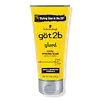What's inside
What's inside
 Key Ingredients
Key Ingredients

No key ingredients
 Benefits
Benefits

 Concerns
Concerns

 Ingredients Side-by-side
Ingredients Side-by-side

Water
Skin ConditioningVp/Va Copolymer
Hydroxyethylcellulose
Emulsion StabilisingTocopherol
AntioxidantCitric Acid
BufferingPhenoxyethanol
PreservativeCitrus Grandis Seed Extract
AstringentParfum
MaskingAloe Barbadensis Leaf Juice
Skin ConditioningHelianthus Annuus Seed Oil
EmollientGlycine Soja Seed Extract
Skin ConditioningBetula Alba Bud Extract
Skin ConditioningMalva Sylvestris Extract
AstringentAchillea Millefolium Extract
CleansingChamomilla Recutita Flower Extract
MaskingEquisetum Arvense Extract
AstringentLavandula Angustifolia Extract
Skin ConditioningRosmarinus Officinalis Leaf Extract
AntimicrobialSalvia Sclarea Extract
AntiseborrhoeicThymus Vulgaris Extract
PerfumingTussilago Farfara Flower Extract
AstringentUrtica Dioica Extract
AstringentWater, Vp/Va Copolymer, Hydroxyethylcellulose, Tocopherol, Citric Acid, Phenoxyethanol, Citrus Grandis Seed Extract, Parfum, Aloe Barbadensis Leaf Juice, Helianthus Annuus Seed Oil, Glycine Soja Seed Extract, Betula Alba Bud Extract, Malva Sylvestris Extract, Achillea Millefolium Extract, Chamomilla Recutita Flower Extract, Equisetum Arvense Extract, Lavandula Angustifolia Extract, Rosmarinus Officinalis Leaf Extract, Salvia Sclarea Extract, Thymus Vulgaris Extract, Tussilago Farfara Flower Extract, Urtica Dioica Extract
Water
Skin ConditioningSorbitol
HumectantPvp
Emulsion StabilisingVinyl Caprolactam/Vp/Dimethylaminoethyl Methacrylate Copolymer
Skin ConditioningPetrolatum
EmollientVp/Dmapa Acrylates Copolymer
Cetyl Alcohol
EmollientSteareth-21
CleansingStearyl Alcohol
EmollientCorn Starch Modified
AbsorbentParfum
MaskingDicetyl Phosphate
EmulsifyingCeteth-10 Phosphate
CleansingDMDM Hydantoin
PreservativeCera Alba
EmollientHydroxyethylcellulose
Emulsion StabilisingPropylene Glycol
HumectantDiazolidinyl Urea
PreservativeMyristyl Alcohol
EmollientArachidyl Alcohol
EmollientBenzalkonium Chloride
AntimicrobialPolyaminopropyl Biguanide
PreservativeIodopropynyl Butylcarbamate
PreservativeWater, Sorbitol, Pvp, Vinyl Caprolactam/Vp/Dimethylaminoethyl Methacrylate Copolymer, Petrolatum, Vp/Dmapa Acrylates Copolymer, Cetyl Alcohol, Steareth-21, Stearyl Alcohol, Corn Starch Modified, Parfum, Dicetyl Phosphate, Ceteth-10 Phosphate, DMDM Hydantoin, Cera Alba, Hydroxyethylcellulose, Propylene Glycol, Diazolidinyl Urea, Myristyl Alcohol, Arachidyl Alcohol, Benzalkonium Chloride, Polyaminopropyl Biguanide, Iodopropynyl Butylcarbamate
 Reviews
Reviews

Ingredients Explained
These ingredients are found in both products.
Ingredients higher up in an ingredient list are typically present in a larger amount.
Hydroxyethylcellulose is used to improve the texture of products. It is created from a chemical reaction involving ethylene oxide and alkali-cellulose. Cellulose is a sugar found in plant cell walls and help give plants structure.
This ingredient helps stabilize products by preventing ingredients from separating. It can also help thicken the texture of a product.
This ingredient can also be found in pill medicines to help our bodies digest other ingredients.
Learn more about HydroxyethylcelluloseParfum is a catch-all term for an ingredient or more that is used to give a scent to products.
Also called "fragrance", this ingredient can be a blend of hundreds of chemicals or plant oils. This means every product with "fragrance" or "parfum" in the ingredients list is a different mixture.
For instance, Habanolide is a proprietary trade name for a specific aroma chemical. When used as a fragrance ingredient in cosmetics, most aroma chemicals fall under the broad labeling category of “FRAGRANCE” or “PARFUM” according to EU and US regulations.
The term 'parfum' or 'fragrance' is not regulated in many countries. In many cases, it is up to the brand to define this term.
For instance, many brands choose to label themselves as "fragrance-free" because they are not using synthetic fragrances. However, their products may still contain ingredients such as essential oils that are considered a fragrance by INCI standards.
One example is Calendula flower extract. Calendula is an essential oil that still imparts a scent or 'fragrance'.
Depending on the blend, the ingredients in the mixture can cause allergies and sensitivities on the skin. Some ingredients that are known EU allergens include linalool and citronellol.
Parfum can also be used to mask or cover an unpleasant scent.
The bottom line is: not all fragrances/parfum/ingredients are created equally. If you are worried about fragrances, we recommend taking a closer look at an ingredient. And of course, we always recommend speaking with a professional.
Learn more about ParfumWater. It's the most common cosmetic ingredient of all. You'll usually see it at the top of ingredient lists, meaning that it makes up the largest part of the product.
So why is it so popular? Water most often acts as a solvent - this means that it helps dissolve other ingredients into the formulation.
You'll also recognize water as that liquid we all need to stay alive. If you see this, drink a glass of water. Stay hydrated!
Learn more about Water